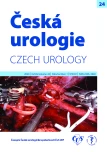Robotic‑assisted vesicovaginal fistula repair: step by step
Authors:
Markéta Matějková
Authors‘ workplace:
Urologické oddělení, ÚVN Praha
Published in:
Ces Urol 2020; 24(1): 15-17
Category:
Video
Overview
Introduction: Vesicovaginal fistula is a patho ‑ logical communication between the bladder and the vagina. It most commonly occurs as a postpartum complication in developing countries and as an iatrogenic postoperative complication in developed countries. The presented video illustrates the surgical procedure in individual steps.
Material and methods: In the period from 11/2005 to 05/2019, a total of 15 patients underwent robotic-assisted vesicovaginal fistula repair using the da Vinci S and Si systems at our centre. All the patients developed a fistula after previous gynaecological surgery, with their symptoms developing within 2 to 6 weeks following the procedure. In nine patients, it was previous surgery for a benign condition (uterine fibroids); three patients had hypermenorrhoea; another three patients were indicated for surgical management of malignant disease – two for endometrial cancer and one for cervical cancer. Ten patients underwent laparoscopic-assisted vaginal hysterectomy; four patients had classic abdominal surgery. One of the patients had laparoscopic surgery first. Because of postoperative bleeding, an open revision was performed within 24 hours of the procedure with a bladder suture. In two patients, previous attempts at closing the fistula (laparoscopic and open – abdominal approach) failed. In another patient, only one laparoscopic attempt at closing the fistula failed.
Results: The average operation time was 151 (105–192) minutes; blood losses were unmeasurable in all the patients. The average durationof hospital stay was 12 (6–19) days. The average catheterization time was 12 (9–18) days. We intentionally left an indwelling catheter in place for 12 days initially, sometimes even longer for a sense of security, and based on the surgeon’s decision, decreased the catheterization time gradually. On day 11, one of the patients pulled out her catheter accidentally and experienced bleeding; thus, the catheter was left in place for additional 7 days. No early or late postoperative complications were noted in any of the patients. All the patients underwent follow-up cystoscopy at three months after surgery and no fistula recurrence was observed in any of them. We performed this on a routine basis to check the general condition and capacity of the bladder, as well as the status of the scar and ureteral orifices.
Conclusion: In developed countries, a vesico ‑ vaginal fistula occurs as a complication following gynaecological surgery for benign disease in 80%, due to obstetric trauma in 10%, after radiotherapy in 5%, and as a complication of gynaecological oncological surgery in 5%. Given the increasing num ‑ ber of gynaecological procedures, complications will certainly be on the rise and their management will require adequate care. The robotic approach is among the most up-to-date methods, allowing for a more rapid and accurate surgical procedure and reducing the recovery time. Our five-year results show a 100% efficacy of this method in patients with a fistula due to previous surgery.
Keywords:
Vesicovaginal fistula – robotic surgery
Labels
Paediatric urologist Nephrology UrologyArticle was published in
Czech Urology

2020 Issue 1
Most read in this issue
- Our experience with MRI/TRUS software fusion for targeted prostate biopsies
- Multi-resistant gram negative bacteria in urology
- Hereditary renal cell carcinoma syndromes
- Case report of a gigantic recurrent angiomyolipoma in a horseshoe kidney
